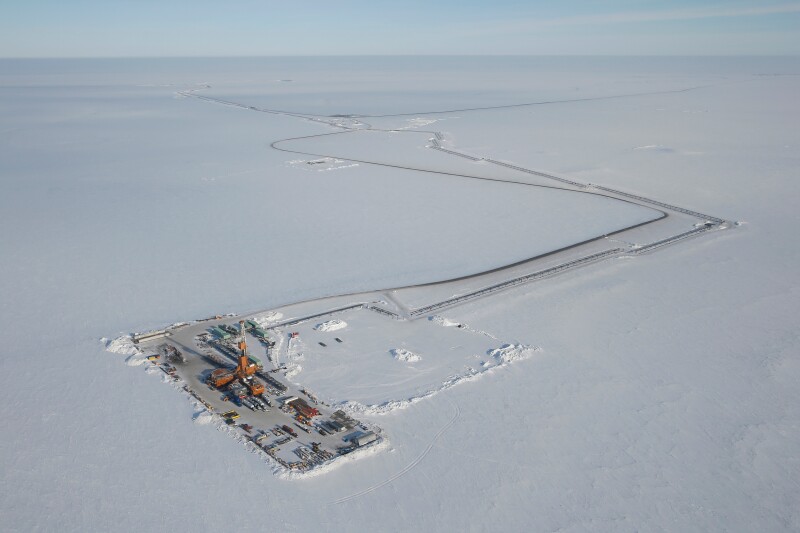
The fate of ConocoPhillips’ Willow Project on the Alaskan North Slope is clearer now with the release by the US Bureau of Land Management (BLM) of a court-ordered draft supplemental environmental impact statement (SEIS) to the project’s master development plan (MDP).
The new environmental assessment for the estimated $6-billion development project in the Bear Tooth Unit of the National Petroleum Reserve in Alaska (NPR-A) proposes several development alternatives, including not building it at all.
The US independent announced the discovery of the Willow oil play in 2017, saying the following year that it believed between 450 and 800 million BOE were in the play. Peak production from the play is pegged at about 160,000 BOPD.
A final investment decision for the project was expected in 2021; however, the US District Court of Alaska blocked the project by vacating environmental assessments previously approved by the BLM and the US Fish and Wildlife Service.
The court ordered both agencies to reevaluate the project’s effect on greenhouse-gas (GHG) emissions along with its impact on wildlife, and reissue new findings before the project could move forward.
The draft SEIS released on 8 July includes a corrected and expanded analysis of potential climate impacts associated with the Willow Project, according to the BLM.
“This expanded climate analysis, among other things, addresses the court’s finding that the original analysis failed to consider downstream foreign emissions resulting from the consumption of oil produced by the project,” the agency said in a statement.
Total GHG emissions range from about 278,000 to 286,000 metric tonnes of carbon dioxide equivalent for a 30-year or 31-year (depending on development option selected) duration of the Willow Project, according to the SEIS.
Alternatives Under Consideration
Under the “no action” alternative, the Willow Project would not be constructed, but oil and gas exploration in the area would continue. Other options proposed in the more than 400 pages of the Willow MDP Draft Supplemental EIS include one that shrinks the project to three drilling pads, down from the five initially proposed by ConocoPhillips.
Its plan, noted as Alternative B, would extend an all-season gravel road from the Greater Mooses Tooth 2 (GMT-2) development southwest toward the Willow Project area, with gravel roads connecting all project facilities, including the proposed processing and operations facilities, an airstrip, and all five drill sites.
This plan includes the construction of 37.4 miles of gravel road and seven bridges. Infield, multiphase pipelines would connect individual drill sites to the processing facility, and export/import pipelines would connect the processing facility to infrastructure on the North Slope.
According to the SEIS, this option provides an all-season gravel access road from the existing gravel road network in the GMT and Alpine developments to Willow Project facilities. It also would “allow for additional operational safety and risk reduction by providing redundancies and additional contingencies for each project and would support potential future development,” the report said.
Alternative C would include the same gravel access road between GMT-2 and the Willow Project area, but there would be no road connecting the processing facilities to the Bear Tooth-1 (BT1) wellsite. This well would be connected to the B2 and B4 wellsites for a total of 35.4 miles of gravel roads with six bridges.
Additionally, this option includes the construction of a 3.6-mile-long annual ice road for movement of heavy equipment between the wellsites and a 545.9-acre gravel footprint to meet infrastructure and facilities requirements. It would include four valve pads, four pipeline pads, three water source access pads, and more.
This option would reduce effects to caribou movement and decrease the number of stream crossings required, according to the SEIS.
Under Alternative D, the processing facility would be co-located with the BT3 wellsite. This option includes the construction of four additional drill sites, the operations center, pipeline and valve pads, a freshwater reservoir, two water source access roads and pads at the reservoir and Lake M0235.
This option would expand the existing gravel pads at ConocoPhillips’ Alpine and Kuparuk developments to accommodate Willow Project facilities and infrastructure, while minimizing the project’s footprint, reducing the number of bridges needed to six vs. eight, and lessen the length of infrastructure on the landscape to decrease effects on caribou movement and subsistence.
Alternative E would reduce the number of drill pads from five to three, but does defer construction of a fourth drill pad to a later date. This option is the most extensive, with changes including the relocation of the BT2 wellsite to gain access to a portion of the target reservoir that would have been captured by BT4 if it had been built. The BT5 wellsite would also be relocated about 1.8 miles northeast to avoid two yellow-billed loon buffer setbacks.
According to the SEIS, this alternative was developed by BLM and cooperating agencies to reduce surface impacts, in response to the District Court’s remand decision.
"Eliminating BT4 would reduce the project’s overall gravel footprint, though the BT1 and BT2 gravel pads would be approximately 100 feet longer to accommodate additional wells, which would allow access to portions of the resource that would otherwise be accessed from BT4 and the alternate BT2 location. Eliminating BT4 and relocating BT5 would reduce the overall length of infield pipelines, gravel roads, and ice roads, and reduce freshwater use," the draft SEIS stated.
Public Response
The Willow Project is estimated to generate more than $10 billion in revenue for state, local, and federal governments during its lifespan, according to US Senator Dan Sullivan, who called the issuance of the draft SEIS a “step in the right direction” in a statement released on 8 July.
“Getting this draft supplemental EIS is another important step in the Willow process, but the devil is in the details as this undergoes review,” he said.
“Unfortunately, the Biden administration rescinded the 2020 NPR-A Integrated Activity Plan and delayed action on the Willow SEIS after an Alaskan federal court remanded the record of decision back to the BLM, despite this project having broad-based support among all stakeholders in Alaska.
“We’re not there yet and have a ways to go, but this is a step in the right direction on an energy project which is enormously important for Alaska and America,” Sullivan said.
But not all see the release of the draft SEIS as a positive step. Environmental group Earthjustice said in a release that "the Willow Project, if approved, would lock in three decades of fossil fuel extraction in Alaska’s rapidly warming tundra, releasing more than 275 million metric tons of carbon dioxide into the atmosphere."
The proposed plans are up for discussion during a 45-day public comment period, according to the BLM. A series of meetings and hearings to gather input on the proposed options also is planned during this time.

